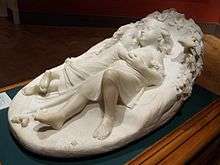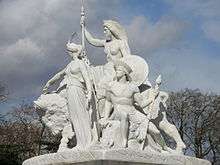John Bell (sculptor)



John Bell (1811–1895) was a British sculptor, born in Bell's Row, Great Yarmouth, Norfolk. His family home was Hopton Hall, Suffolk. His works were shown at the Great Exhibition of 1851, and he was responsible for the marble group representing "America" on the Albert Memorial in London.
Life
He was born in 1811, and educated at Catfield rectory, Norfolk. He studied sculpture in the Royal Academy schools, and exhibited his first work at the academy, a religious group, in 1832. The next year he exhibited A Girl at a Brook and John the Baptist at the academy, and two statuettes at the Suffolk Street Gallery, followed by Ariel in 1834. At the Royal Academy in 1836 he showed Psyche feeding a Swan and Youth, Spring, and Infancy. [1]
In 1837, the year in which Bell established his reputation, his works at the Academy included Psyche and the Dove and a model of The Eagle-Shooter, the first version of what was to become one of his most celebrated statues;[1][2] he also exhibited two busts, Amoret and Psyche, at the British Institution. [1] His Babes in the Wood was exhibited at the Royal Academy summer exhibition two years later. There are marble versions at Osborne House, and Norwich Castle.
In 1844 Bell entered his Eagle Slayer and Jane Shore in the competition held for sculpture for the new Houses of Parliament. A cast-iron version of the Eagle Slayer - the first statue ever to be made from the material - was produced for The Great Exhibition of 1851, where it stood under a canopy surmounted by the eagle. It was later placed outside the South Kensington Museum, and is now in the V&A Museum of Childhood in Bethnal Green.[3] He also exhibited a sculpture of Shakespeare at the 1851 exhibition, which was widely reproduced, for example on the front page of Recollections of the Great Exhibition.[4] It was also used by John Leech as the centrepiece of his cartoon Dinner-time at the Crystal Palace, published in Punch.
For Coalbrookdale he created the Deerhound hall table and Andromeda which was bought by Queen Victoria and is now a feature of the gardens at Osborne House.
Una and the Lion, inspired by Edmund Spenser's The Faerie Queene was also exhibited at the Great Exhibition of 1851, and reproduced in miniature in parian ware by Mintons. The full-scale model was placed in the Crystal Palace which burned down in 1936.
His best-known work is the Crimean war monument to the Brigade of Guards at the junction of Pall Mall and Waterloo Place, London.
Bell's 1862 sculpture of Oliver Cromwell originally designed for the 1862 International Exhibition was erected in 1899 in Warrington, Cheshire.[5]
In 1864 Bell accepted the commission to create a marble group representing America, as one of the four large sculptures representing the continents, for the corners of the Albert Memorial in Kensington Gardens.[6] He decided to create an allegory of human progress in the Americas, with figures representing Canada and the United States in the lead and two others representing Central and South America at the rear, all grouped around a massive bison.[6] He also proposed, unsuccessfully, a kneeling effigy of Prince Albert as a soldier of Christ for the memorial, following the death in 1867 of Carlo Marochetti, who had been working on the prince's statue.[6]
Bell died on 14 March 1895 at 15 Douro Place, Kensington.[1]
His pupil Francis John Williamson also became a successful sculptor, reputed to have been Queen Victoria's favourite.[7]
References
- 1 2 3 4 Dodgson 1901.
- ↑ The other work he showed that year was Infant Hercules Strangling the Snakes; see Graves, Algernon (1905). The Royal Academy: A Complete Dictionary of Contributors from its Foundations in 1769 to 1904. 1. London: Henry Graves. p. 174.
- ↑ "The Eagle Slayer". Victoria and Albert Museum. Retrieved 24 February 2015.
- ↑ "Displays". ku.edu.
- ↑ Historic England, "Statue of Oliver Cromwell, Bridge Street (1139417)", National Heritage List for England, retrieved 18 February 2016
- 1 2 3 Bayley 1983, p. 100.
- ↑ "Francis John Williamson (1833-1920)". The Victorian Web. Retrieved 29 August 2013.
Sources
- Bayley, Stephen (1983). The Albert Memorial. London: Scholar Press. pp. 87–9. ISBN 9780859675949.
- Attribution
![]() This article incorporates text from a publication now in the public domain: Dodgson, Campbell (1901). "Bell, John (1811-1895)". In Sidney Lee. Dictionary of National Biography, 1901 supplement. London: Smith, Elder & Co.
This article incorporates text from a publication now in the public domain: Dodgson, Campbell (1901). "Bell, John (1811-1895)". In Sidney Lee. Dictionary of National Biography, 1901 supplement. London: Smith, Elder & Co.
External links
- "Drawings for Sculpture of 'America'". Paintings & Drawings. Victoria and Albert Museum. Retrieved 2011-04-03.
- yourarchives.nationalarchives.gov.uk
- myweb.tiscali.co.uk
- frontierpublishing.co.uk
- rsa.org.uk
- spencer.lib.ku.edu
- youricons.macrojuice.com
- museums.norfolk.gov.uk
| Wikimedia Commons has media related to John Bell. |